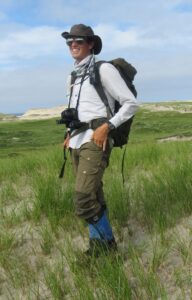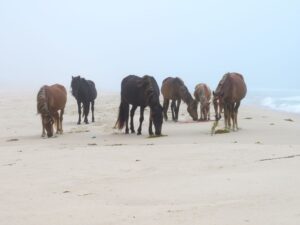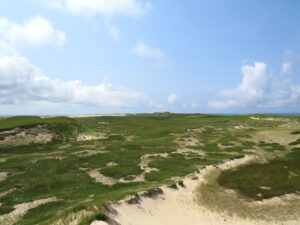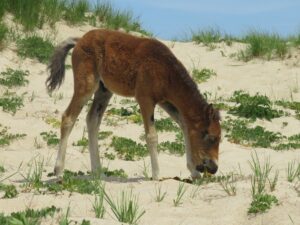**The AGA grants EECG Research Awards each year to graduate students and post-doctoral researchers who are at a critical point in their research, where additional funds would allow them to conclude their research project and prepare it for publication. EECG awardees also get the opportunity to hone their science communication and write posts over their grant tenure for the AGA Blog. In the first in the series, our EECG awardees write about their research and their interests as an ’embarkation’.**
 About the Blog Post Author: Mason Stothart (he/him) is a PhD candidate in the lab of Dr. Jocelyn Poissant at the University of Calgary, where he is using quantitative genetic tools to study the host-microbiome relationship in the feral horses of Sable Island. Mason is broadly interested in understanding the causes, fitness consequences, and transmission of microbiome variation within wild animal populations. You can follow Mason’s research on twitter (@M_Stothart), Google Scholar, or on his website (stothartresearch.com).
About the Blog Post Author: Mason Stothart (he/him) is a PhD candidate in the lab of Dr. Jocelyn Poissant at the University of Calgary, where he is using quantitative genetic tools to study the host-microbiome relationship in the feral horses of Sable Island. Mason is broadly interested in understanding the causes, fitness consequences, and transmission of microbiome variation within wild animal populations. You can follow Mason’s research on twitter (@M_Stothart), Google Scholar, or on his website (stothartresearch.com).
Land Acknowledgement: The University of Calgary—where Mason is completing his PhD—is on the traditional territories of the people of the Treaty 7 region in Southern Alberta, which includes the Blackfoot Confederacy (comprising the Siksika, Piikani, and Kainai First Nations), as well as the Tsuut’ina First Nation, and the Stoney Nakoda (including the Chiniki, Bearspaw, and Wesley First Nations). The City of Calgary is also home to Métis Nation of Alberta, Region 3. However, Mason’s research takes place on Sable Island off the coast of Nova Scotia, which is located in Mi’kma’ki, the ancestral and unceded territory of the Mi’kmaq people.
“Old longings nomadic leap
Chafing at custom’s chain
Again from its brumal sleep
Wakens the ferine strain.”
– John Myers O’Hara, Atavism, Stanza 1 (1902)
Epigraph to Jack London’s ‘Call of the Wild’
Far off the eastern coast of Nova Scotia, sun-bleached horses walk the windswept wrack line of Sable Island (Figure 1). Horses were first introduced to this culturally and ecologically significant sandbar over 260 years ago, and they have remained largely unmanaged ever since. In the absence of predators, this feral population is primarily food- and nutrient-limited. But to extract nutrients from their fibrous plant diet, these horses obligately reliant on communities of microbiota (microbiomes) residing in their gastro-intestinal tract (Julliand & Grimm, 2017). The outcome of host-microbiome interactions can be affected by functional differences between microbial sub-species (strains). However, the evolutionary importance of functional variation in host-associated microbiomes has yet to be demonstrated in the wild. As a closed population of long-lived hindgut fermenters which are not well-adapted to their island home (Figure 2), Sable Island horses stand at the confluence of conditions under which adaptation via the host-associated microbiome is predicted to occur (Alberdi, Aizpurua, Bohmann, Zepeda-Mendoza, & Gilbert, 2016).

The boundaries of biological individuality have begun to blur with our growing understanding of host-microbiome symbioses. In vertebrates, arguably some of the most intimate of these symbioses occurs in the intestinal tract, which harbours diverse communities of bacteria, fungi, archaea, and protists. Rather than bystanders to host physiological processes, constituents of the microbiome are now recognized to affect a range of host traits (behaviour, immunity, diet detoxification, metabolism), and can thereby generate phenotypic variation among hosts which is visible to natural selection. In doing so, host-associated microbiomes might help to define the realized niche of their animal host and affect how hosts respond to environmental challenges (Henry, Bruijning, Forsberg, & Ayroles, 2021).
The newly recognized importance of the microbiome has spurred hypotheses which posit that, to understand how multicellular life evolves, it is important to view the host genome and summed genomic contents of the microbiome (metagenome) as part of an integrated whole (Zilber-Rosenberg & Rosenberg, 2008). However, despite theorization, it remains to be seen whether microbiome variation can cause fitness differences between hosts, or whether fitness-related microbiome variation can be faithfully transmitted across host generations in the wild (Suzuki, 2017). Unfortunately, many free-living animal populations are intractable for the types of detailed longitudinal sampling required to study these patterns.

The horses of Sable Island provide a valuable opportunity to research the genetic/non-genetic causes and fitness consequences of microbiome variation in nature. Since 2007, the birth, social network, movement, reproduction, and death of every horse on Sable Island (~350 – 600 individuals annually) has been closely monitored as part of a long-term individual-based ecological study. Alongside the maintenance of a population pedigree, since 2013, we have amassed an archive of thousands of fecal samples (spanning >1000 individuals). Using these archived fecal samples and a shallow shotgun sequencing approach (Stothart, McLoughlin, & Poissant, 2022), I am building upon my past research in this system (Stothart et al., 2021) by quantifying the relationships between horse survival/reproductive success and microbiome community structure/functional potential, as well as estimating the heritability and non-genetic transmissibility of fitness-associated microbiome variation (Figure 3).

Preliminary analyses of these data have yielded interesting results, including some patterns which appear to be microbial strain-specific. However, the bioinformatic processing of these shotgun metagenomic sequences has (until now) relied on publicly available reference genome databases. This can limit the resolution of taxonomic and functional potential features in the microbiome, and therefore, obscure more nuanced biological patterns. The AGA EECG funds will be used to create Sable Island horse specific metagenome assembled genomes using long-read sequencing. These microbial reference genomes will greatly improve the quality of current and future metagenomics research in this remarkable study system, and help to launch new lines of inquiry. I am grateful for the support and excited to share the results of this research with the American Genetics Association membership!
References



